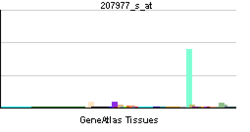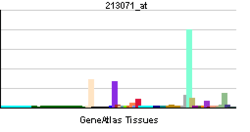Dermatopontin
| DPT | ||||||
|---|---|---|---|---|---|---|
| Identifiers | ||||||
| Aliases | DPT, TRAMP, dermatopontin | |||||
| External IDs | MGI: 1928392 HomoloGene: 1458 GeneCards: DPT | |||||
| RNA expression pattern | ||||||
   | ||||||
| More reference expression data | ||||||
| Orthologs | ||||||
| Species | Human | Mouse | ||||
| Entrez | ||||||
| Ensembl | ||||||
| UniProt | ||||||
| RefSeq (mRNA) | ||||||
| RefSeq (protein) | ||||||
| Location (UCSC) | Chr 1: 168.7 – 168.73 Mb | Chr 1: 164.8 – 164.82 Mb | ||||
| PubMed search | [1] | [2] | ||||
| Wikidata | ||||||
| View/Edit Human | View/Edit Mouse |
Dermatopontin is a protein that in humans is encoded by the DPT gene.[3][4]
Function
Dermatopontin is an extracellular matrix protein with possible functions in cell-matrix interactions and matrix assembly. The protein is found in various tissues and many of its tyrosine residues are sulphated. Dermatopontin is postulated to modify the behavior of TGF beta through interaction with decorin.[4]
References
- ↑ "Human PubMed Reference:".
- ↑ "Mouse PubMed Reference:".
- ↑ Superti-Furga A, Rocchi M, Schafer BW, Gitzelmann R (Oct 1993). "Complementary DNA sequence and chromosomal mapping of a human proteoglycan-binding cell-adhesion protein (dermatopontin)". Genomics. 17 (2): 463–7. doi:10.1006/geno.1993.1348. PMID 8104875.
- 1 2 "Entrez Gene: DPT dermatopontin".
Further reading
- Pochampally RR, Ylostalo J, Penfornis P, et al. (2007). "Histamine receptor H1 and dermatopontin: new downstream targets of the vitamin D receptor.". J. Bone Miner. Res. 22 (9): 1338–49. doi:10.1359/jbmr.070605. PMID 17547532.
- Gregory SG, Barlow KF, McLay KE, et al. (2006). "The DNA sequence and biological annotation of human chromosome 1.". Nature. 441 (7091): 315–21. doi:10.1038/nature04727. PMID 16710414.
- Gerhard DS, Wagner L, Feingold EA, et al. (2004). "The status, quality, and expansion of the NIH full-length cDNA project: the Mammalian Gene Collection (MGC).". Genome Res. 14 (10B): 2121–7. doi:10.1101/gr.2596504. PMC 528928
 . PMID 15489334.
. PMID 15489334. - Strausberg RL, Feingold EA, Grouse LH, et al. (2003). "Generation and initial analysis of more than 15,000 full-length human and mouse cDNA sequences.". Proc. Natl. Acad. Sci. U.S.A. 99 (26): 16899–903. doi:10.1073/pnas.242603899. PMC 139241
 . PMID 12477932.
. PMID 12477932. - Shaheduzzaman S, Krishnan V, Petrovic A, et al. (2002). "Effects of HIV-1 Nef on cellular gene expression profiles.". J. Biomed. Sci. 9 (1): 82–96. doi:10.1007/BF02256581. PMID 11810028.
- Kuroda K, Okamoto O, Shinkai H (1999). "Dermatopontin expression is decreased in hypertrophic scar and systemic sclerosis skin fibroblasts and is regulated by transforming growth factor-beta1, interleukin-4, and matrix collagen.". J. Invest. Dermatol. 112 (5): 706–10. doi:10.1046/j.1523-1747.1999.00563.x. PMID 10233760.
- Okamoto O, Fujiwara S, Abe M, Sato Y (1999). "Dermatopontin interacts with transforming growth factor beta and enhances its biological activity.". Biochem. J. 337 (3): 537–41. doi:10.1042/0264-6021:3370537. PMC 1220007
 . PMID 9895299.
. PMID 9895299. - Forbes EG, Cronshaw AD, MacBeath JR, Hulmes DJ (1994). "Tyrosine-rich acidic matrix protein (TRAMP) is a tyrosine-sulphated and widely distributed protein of the extracellular matrix.". FEBS Lett. 351 (3): 433–6. doi:10.1016/0014-5793(94)00907-4. PMID 8082810.
This article is issued from Wikipedia - version of the 6/6/2016. The text is available under the Creative Commons Attribution/Share Alike but additional terms may apply for the media files.